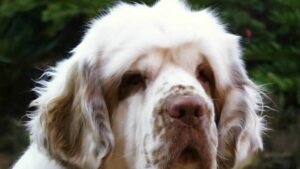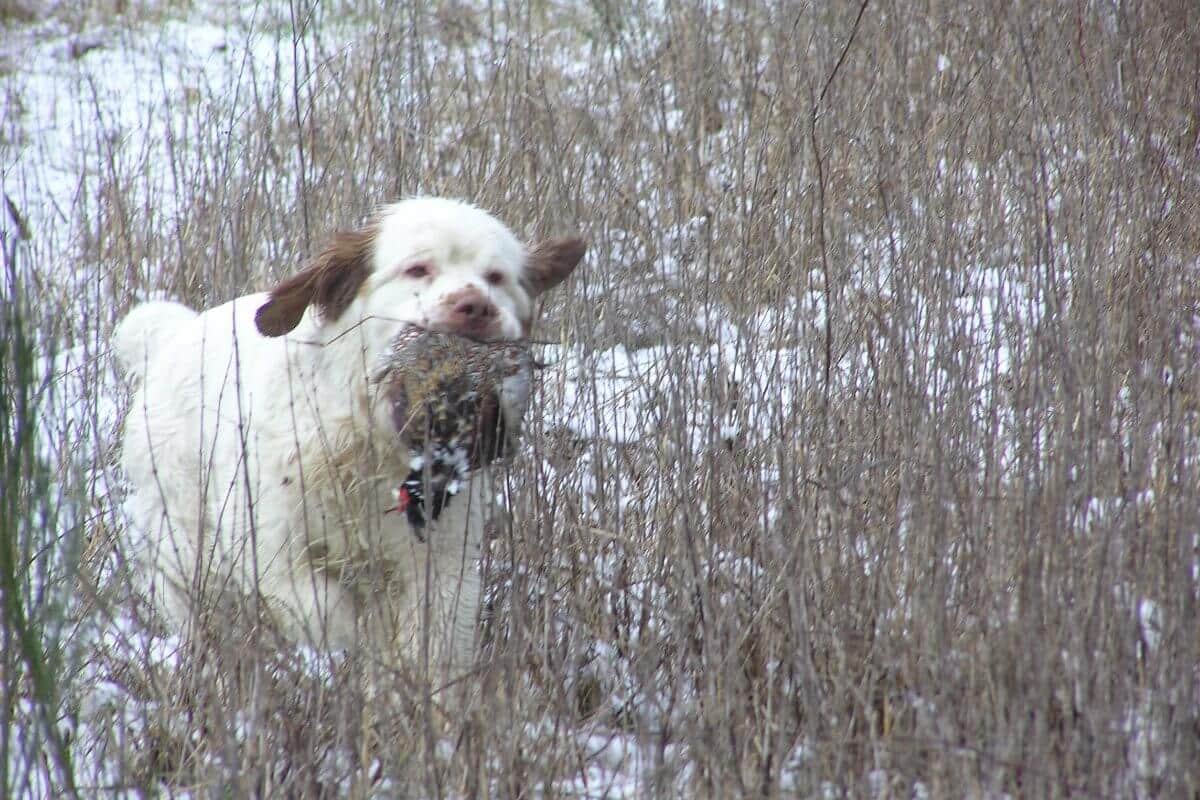
Judging the Clumber Spaniel
Discover the nuances of judging Clumber Spaniels & avoid common pitfalls. Learn to prioritize breed-specific qualities over generic standards.
Home » Meet The Breeds » Clumber Spaniel





The Clumber Spaniel, originating from the United Kingdom, is a breed that exudes a sense of nobility and grace. Recognized for its distinctive, heavy-set frame and gentle demeanor, the Clumber holds a special place in the hearts of many, serving as both a diligent worker and a loyal and affectionate companion.
Sporting
17-20 Inches
55-85 Pounds
10-12 Years
The Clumber Spaniel, characterized by its distinctive appearance and affable nature, boasts a rich history that traces back to the 18th century.
Originating from the United Kingdom, specifically in the region of Nottinghamshire, the breed takes its name from Clumber Park, the estate of the Duke of Newcastle. It is believed that the Clumber Spaniel was developed by crossing older breeds of Alpine Spaniels with Basset Hounds and perhaps other breeds. This mix resulted in a dog with a sturdy build, keen nose, and a calm temperament, making it an ideal companion for hunting in dense terrains.
Unlike the more sprightly spaniels, the Clumber was designed for deliberate and methodical work in the field, often being used to push through thick underbrush in pursuit of game. Its strength and persistence made it a favorite among nobility, including Prince Albert, Queen Victoria’s consort, who took a keen interest in the breed.
In terms of official recognition, the Clumber Spaniel’s prominence in England led to its early acknowledgment by The Royal Kennel Club (UK). The breed made its way across the Atlantic early on, and by the late 19th century it was one of the first breeds to be recognized by the American Kennel Club (AKC). The Fédération Cynologique Internationale (FCI) also recognizes the breed, further cementing its standing in the international canine community.
Over the years, the breed’s role shifted from primarily being a hunting companion to that of a beloved family pet. Its gentle demeanor, combined with its distinctive looks, ensures its continued popularity, even if it’s not as commonly seen in the field today.
The legacy of the breed is a testament to its adaptability and charm. From the sprawling estates of English nobility to modern homes around the world, the breed’s history is as rich and varied as its character.
Males typically stand between 18 to 20 inches at the shoulder, while females measure around 17 to 19 inches.
In terms of weight, males usually fall within the range of 70 to 85 pounds, whereas females tend to weigh between 55 to 70 pounds. These metrics underscore the breed’s robust nature, with a physique that’s both balanced and commanding.
The Clumber Spaniel’s body is long and low, with a deep chest. This rectangular silhouette gives the breed its unique appearance, differentiating it from other spaniels. It has a substantial bone structure, emphasizing its strength and endurance capabilities. Despite its heavy-set form, the breed moves with surprising fluidity and grace, a testament to its well-balanced proportions.
Texture: The Clumber Spaniel’s coat is dense and straight, offering protection in harsh environments and inclement weather. The breed’s coat is primarily characterized by its soft-to-the-touch texture, but it is also remarkably resilient, ensuring minimal tangling when the dog moves through dense underbrush.
Clumber Spaniel Colors:
| Standard Marking | |
|---|---|
| Lemon Markings | ee |
| Orange Markings | ee |
A Note About Color: Facial markings can appear around one or both eyes, as freckling on the muzzle and/or legs, and as a spot on the top of the head, and/or a spot at the base of the tail. Markings on the body are discouraged.
The Clumber’s tail is set low, complementing the breed’s relaxed demeanor. It is thick at the base and tapers towards the end, a perfect counterpart to the robust nature of the breed. When the dog is at rest, the tail hangs naturally; however, when in motion or alert, it is carried level with the back but not much above it. The tail adds to the breed’s rather dignified appearance and serves as a barometer of its mood.
While Clumber Spaniels have traditionally had their tails docked, the practice has decreased in popularity, and many are now left undocked, allowing the full, feathery length of the tail to be displayed.
The decision to own a Clumber Spaniel, as with any breed, comes with a unique set of considerations. Their regal appearance of the breed, combined with its somewhat calm disposition, makes the Clumber an appealing choice for many. Prospective owners, however, should be mindful of the breed’s specific needs and characteristics.
The Clumber Spaniel, with its robust frame and genial demeanor, generally boasts good health. However, as with all dogs, individuals of this breed can be predisposed to certain health issues. Regular veterinary check-ups are crucial to ensure that the Clumber is maintaining optimal health and to catch potential concerns early on.
Lifespan: On average, Clumber Spaniels have a life expectancy of 10 to 12 years. Proper care, nutrition, and regular health monitoring can contribute to a longer, healthier life for this playful and loving companion.
Clumber Spaniels, like all dog breeds and mixed breeds, have certain health concerns to which they may be more predisposed. Some of the most commonly observed health issues include:
In light of these potential health concerns, it’s essential for owners to be proactive. Regular veterinary visits, ideally twice a year, can help to catch and address issues before they become problematic. Routine screenings, especially for any conditions to which the breed may be predisposed, can be crucial towards ensuring a dog’s long-term health and overall well-being.
The Clumber Spaniel, with its calm and dignified demeanor, has been known to capture many unsuspecting hearts. For novice dog owners looking for a loyal companion, the Clumber Spaniel is an excellent choice due to its docile and patient temperament. The breed’s eagerness to please and relative ease of training can quickly build a deep bond between any dog and its people.
One of the defining characteristics of the Clumber Spaniel is its sensitivity. These dogs form close bonds with their human families, and sudden changes in their environment or daily routine might may unsettle them. Thus, it’s beneficial to introduce them to new situations or surroundings with care and patience.
While the Clumber Spaniel cherishes companionship and thrives in the company of its family, it can also tolerate being alone for a short time. However, extended periods of isolation aren’t advisable, as this can lead to feelings of loneliness or anxiety in the dog.
In households with other pets, the Clumber Spaniel typically gets along well with others, showcasing its non-aggressive and affable nature. This amicable trait extends to human interactions as well; Clumbers tend to be good with young children, making them excellent family pets. Of course, interactions between dogs and young children should always be supervised for safety.
When it comes to strangers, the Clumber Spaniel might exhibit initial reservation but will usually warm up if given a bit of time, reflecting the generally friendly disposition of the breed.
Overall, while the Clumber Spaniel has a range of typical breed characteristics, it’s essential to remember that individual dogs will have unique personalities shaped by their experiences, training, and socialization.
Understanding the dietary needs of a Clumber Spaniel is vital for its overall health and well-being. This breed, characterized by its robust build and rather calm energy, has specific nutritional requirements that evolve as it transitions from a puppy to an adult.
When it comes to feeding a Clumber Spaniel puppy, a diet rich in essential nutrients that support bone and muscle development is imperative. Puppy-specific formulas, often dense in calories and nutrients, are recommended. The exact amount of food will depend on the puppy’s age, weight, and activity level, but it’s essential to divide the daily portion into multiple meals to support the pup’s rapid growth and metabolism.
As the Clumber Spaniel matures into adulthood, its nutritional needs shift. An adult Clumber’s diet should be balanced, containing the right proportions of protein, fats, and carbohydrates. On average, a mature dog might require 1.5 to 2 cups of high-quality dry dog food daily, divided into two meals. However, individual needs can vary based on the individual’s age, weight, activity level, and overall health.
It’s worth noting that Clumber Spaniels have a notorious love for food, which, if not monitored, can lead to obesity. Ensuring the right portion sizes (and resisting those pleading eyes during meal times) is crucial to maintain a dog’s optimal weight.
Regular vet check-ups and discussions about your Clumber Spaniel’s dietary needs will provide guidance on the best food choices and portion sizes tailored to each dog’s unique requirements.
Training a Clumber Spaniel can be a rewarding experience, given the breed’s eager-to-please nature and its generally affable disposition. Historically bred as hunting dogs, Clumbers come with an innate intelligence, which, when paired with consistent training techniques, can make them well-behaved companions.
The Clumber Spaniel’s trainability is generally high, making the breed adaptable to various training methods. However, the calm and sometimes stubborn demeanor of the breed means that patience is essential during training sessions. Positive reinforcement techniques, such as treats and praise, usually yield the best results.
While they are not known to be excessive barkers, it’s crucial to train a Clumber Spaniel from a young age so the dog understands when barking is appropriate and when it’s not. Unwanted vocal behavior can be influenced by the environment, various stimuli, or even boredom.
When considering their intelligence, Clumber Spaniels can quickly grasp new commands and routines. However, as with all breeds, consistency in training is key. Regular sessions that challenge their mental faculties can help in keeping them engaged and active.
Wanderlust isn’t a prominent trait in the Clumber Spaniel, but it’s still essential to ensure that the dog’s yard is securely fenced or that they’re on-leash during walks. The breed’s hunting lineage can sometimes spark a chase instinct, especially if an intriguing scent is picked up.
Lastly, while the Clumber Spaniel’s hunting instincts may not be as strong as those of some other breeds, the predation drive can still exist. This means that Clumbers might be inclined to chase smaller animals. Early socialization, and introducing them to various environments and animals, can help in curbing this instinct.
The Clumber Spaniel, with its calm and composed demeanor, might give the impression of a laid-back companion, but these dogs have a moderate energy level that nonetheless necessitates regular exercise to keep them physically and mentally stimulated.
| Energy Level | Moderate |
|---|---|
| Exercise Requirements | 30 Minutes/Day, Daily Walks, Regular Exercise, Playing with Another Dog, Mental Stimulation |
While Clumber Spaniels don’t require the same intense exercise regimens as some high-energy breeds, they benefit significantly from daily walks, play sessions, and interactive activities. A couple of short-to-moderate-length walks each day, paired with some playtime in a secure yard, usually suffices to keep them content and healthy.
The intensity of the exercise should align with the Clumber Spaniel’s own pace. Leisurely strolls, rather than high-speed runs, demonstrate just how excellent these dogs can be as companions during relaxed walks in the park or around the neighborhood.
Playfulness is another characteristic of the Clumber. Engaging these dogs in a game of fetch or with interactive toys can be a delightful way to bond with this breed while ensuring they get the exercise they need. However, due to the breed’s somewhat heavier build and potential for joint issues, it’s essential to monitor the intensity of play, especially on harder surfaces.
It’s also worth noting that Clumber Spaniels can be prone to weight gain, especially if they aren’t provided with adequate exercise. Maintaining a consistent exercise routine, combined with a balanced diet, is crucial to ensure they remain at a healthy weight.
Attending to the grooming needs of a Clumber Spaniel is an essential aspect of its care. The breed’s dense, straight coat, characterized by its soft texture and feathering on the legs and belly as well as its neck frill, requires regular attention to keep it looking its best and ensuring the dog’s comfort.
| Coat Type | Dense, Straight, Flat, Soft |
|---|---|
| Grooming Requirements | Daily Combing, Weekly Brushing, Occasional Bathing, Routine Ear Cleaning, Periodic Nail Trimming, Regular Tooth Brushing |
Though the Clumber isn’t a heavy shedder like some other breeds, the breed does shed throughout the year, with increased shedding during seasonal changes. To manage this and reduce the amount of hair around the house, it’s advisable to brush the coat several times a week. Regular brushing not only helps in removing loose hairs, it also prevents the formation of mats and tangles, especially in the feathering.
When it comes to bathing, the Clumber Spaniel doesn’t require frequent baths unless it gets particularly dirty. However, due to the breed’s love for outdoor activities and its close-to-the-ground build, they can pick up dirt more easily than some other breeds. A monthly bath, or as needed, with a gentle dog shampoo can help in keeping the dog’s coat clean and smelling fresh.
It’s also important to remember other grooming essentials, such as nail trimming, ear cleaning, and dental care. Regularly checking and cleaning the Clumber Spaniel’s ears can prevent infections, and maintaining oral health through regular brushing or with dental chews can keep dental issues at bay.
Adapting your home environment to accommodate a Clumber Spaniel ensures that both the dog and the family enjoy a harmonious and comfortable life together. The Clumber’s gentle and laid-back nature often makes it a versatile fit for various living conditions, but understanding the breed’s specific needs is crucial.
Despite their calm disposition, Clumber Spaniels are relatively large dogs, and while they can adjust to apartment living, they’ll still require ample space to move around comfortably. If the dog is expected to live in an apartment or a home without a yard, it is important to ensure that regular walks and outings are provided to compensate for the lack of open space.
Climate can also play a role in the comfort of a Clumber Spaniel. The breed’s dense coat makes it more suited for cooler weather, offering some protection against the cold. However, in hot or humid conditions, Clumbers can become uncomfortable or even face health risks. During warmer months, it’s crucial to provide plenty of water and shaded areas, and to avoid strenuous activities during the hottest parts of the day. Additionally, indoor air conditioning or fans can help to keep them cool.
While Clumber Spaniels are amiable and can adapt to various living situations, it’s also important to consider their potential for shedding and drooling. Regular grooming, as mentioned, can help to manage shedding, but having cleaning tools on hand can be beneficial. Given their tendency to drool, especially after drinking or when they’re hot, having towels or wipes handy can help to maintain cleanliness around the home.
In essence, living with a Clumber Spaniel is a rewarding experience. The breed’s calm and affectionate nature makes it a wonderful companion in many situations. Ensuring that the dog’s living environment caters to its specific needs will guarantee a happy and healthy life for any Clumber.
The arrival of Clumber Spaniel puppies is a joyous occasion, marked by curious eyes and playful antics. These little bundles of joy, though calm and composed for the most part, bring with them a unique set of needs that differs from their adult counterparts. Understanding these needs is fundamental to raising a healthy and well-adjusted Clumber.
In the initial weeks after birth, Clumber Spaniel puppies rely heavily on their mother for nutrition and warmth. As they grow and start exploring their environment, the pups become more active and their dietary needs change. Introducing high-quality puppy food at the recommended age ensures they will receive the essential nutrients for optimal growth and development.
Socialization is another vital aspect of raising Clumber Spaniel puppies. Early exposure to different people, animals, and environments helps with shaping their temperament and reduces the chances of fear or anxious behavior in adulthood. Gentle handling and positive experiences during this period can have lasting benefits.
Ensuring a safe environment for these puppies is crucial, since their curious nature might lead them to explore areas that may not be safe. Puppy-proofing the home by removing small objects that can be swallowed, securing trash bins, and setting up safe play areas can prevent unfortunate accidents from occuring.
Routine veterinary check-ups are essential in the early stages of a Clumber Spaniel’s life. Vaccinations, deworming, and general health assessments ensure that the puppy is on the right track health-wise. It’s also an opportunity to seek advice on feeding, training, and any concerns that may be specific to the breed.
Lastly, introducing basic training commands and housebreaking routines early on can lay the foundation for a well-behaved adult Clumber Spaniel. Positive reinforcement techniques, patience, and consistency play a significant role in this important process.
The Clumber Spaniel’s history as a working gundog and its natural inclination towards certain activities make it suitable for a variety of dog sports and activities. While the breed may not possess the same high-energy drive as some others, the Clumber’s determination and willingness to please can make this dog a stand-out in various disciplines.
In addition to these structured activities, Clumber Spaniels also appreciate casual play sessions, fetch games, and leisurely walks through town or out in nature. Engaging them in a mix of organized dog sports and relaxed activities can contribute to their overall well-being and deepen the bond shared between the dogs and their favorite people.
The Clumber Spaniel is recognized by the world’s leading registries and kennel organizations, which categorize the breed into a specific Group based on its unique characteristics. This breed is recognized worldwide under the following Group designations:
| Organization | Group Designation |
|---|---|
| AKC (American Kennel Club) | Sporting |
| UKC (United Kennel Club) | Gun Dog |
| CKC (Canadian Kennel Club) | Sporting Dogs |
| ANKC (Australian National Kennel Council) | Gundogs |
| RKC (The Royal Kennel Club) | Gundog |
| FCI (Fédération Cynologique Internationale) | Group 8 – Retrievers – Flushing Dogs – Water Dogs ; Section 2 |
The ideal Clumber Spaniel is described by a Breed Standard that is approved by each of the world’s leading registries and kennel organizations. The Breed Standards for this breed may be found in the following links:
| Organization | Breed Standard |
|---|---|
| American Kennel Club | AKC Clumber Spaniel Breed Standard |
| United Kennel Club | UKC Clumber Spaniel Breed Standard |
| Canadian Kennel Club | CKC Clumber Spaniel Breed Standard |
| Australian National Kennel Council | ANKC Clumber Spaniel Breed Standard |
| The Royal Kennel Club | RKC Clumber Spaniel Breed Standard |
| Fédération Cynologique Internationale | FCI Clumber Spaniel Breed Standard |
The world of purebred dogs is enhanced and preserved by the dedicated efforts of breed clubs. These clubs are established to advocate for the breed, promote responsible breeding, provide education, and organize events. For the Clumber Spaniel, there are several notable breed clubs in various countries that work tirelessly to uphold the breed’s integrity and heritage.
In the United States, the primary organization dedicated to Clumber Spaniels is the Clumber Spaniel Club of America (CSCA). Established in 1972, the CSCA offers a wealth of resources for both prospective and current Clumber Spaniel owners. The club hosts social and competitive events, provides meaningful education, and supports responsible breeding practices.
In Canada, the Clumber Spaniel Club of Canada (CSCC) stands out as a primary organization devoted to the breed. Deeply committed to ensuring the well-being of Clumber Spaniels within the country, the CSCC offers an array of resources, from rescue services to breed-specific events and guidance.
In the United Kingdom, the Clumber Spaniel Club (CSC) stands as one of the oldest organizations for the breed, having been established in 1906. With over a century of experience and dedication, the CSC has played a pivotal role in shaping the breed’s written Standard and has provided invaluable support to Clumber Spaniel enthusiasts throughout the UK.
Each of these clubs, among others worldwide, act as pillars of support, knowledge, and advocacy for the Clumber Spaniel. Whether someone is looking to learn more, adopt, or even participate in breed-specific events, reaching out to these organizations can be a great starting point.
The importance of rescue groups in the canine world cannot be overstated. These organizations often step in to provide care, rehabilitation, and new homes for dogs that may have been abandoned, mistreated, or can no longer be cared for by their original owners.
In the US, there are rescue services often linked with or endorsed by AKC “parent clubs” such as the Clumber Spaniel Club of America. The organization’s volunteers work tirelessly to rehabilitate and rehome Clumber Spaniels in need, ensuring the dogs are placed in environments that understand and appreciate the breed’s unique characteristics.
The Clumber Spaniel Club of Canada (CSCC) often provides resources or connections to rescue services tailored for Clumbers within Canada. The group is dedicated to the welfare of the breed and acts as a valuable resource for those looking to adopt a Clumber Spaniel in need.
In the United Kingdom, various breed-specific rescue groups and general spaniel rescue organizations occasionally have a Clumber available for adoption. Collaborating with organizations such as the Clumber Spaniel Club, these rescue organizations prioritize the well-being and proper placement of each dog.
Yes, Clumber Spaniels are known to shed quite profusely. They have a dense, weather-resistant coat that requires regular grooming to keep it healthy and to reduce the amount of loose hair. Brushing them several times a week can help to manage the shedding and keep the coat looking its best.
Clumber Spaniels typically have a lifespan of 10 to 12 years. Like all breeds, their longevity can be influenced by genetics, diet, exercise, and regular veterinary care. Ensuring they have a balanced lifestyle and are kept in good health can contribute to their longevity.
Clumber Spaniels are generally known for their gentle and laid-back demeanor. While they can get along well with cats, especially if raised together from a young age, individual temperaments can vary. As with any breed, it’s essential to make introductions slowly and under controlled conditions to ensure a harmonious relationship.
No, Clumber Spaniels are not considered hypoallergenic. They shed regularly, and their dander can be a trigger for those with allergies. If allergies are a concern, it’s essential to spend time around the breed before making a commitment to be sure it’s a suitable choice.
Yes, Clumber Spaniels are not as commonly found as some other breeds. In fact, they are listed among the Vulnerable Native Breeds in the UK due to their low registration numbers. Their unique appearance and characteristics, however, have garnered them a dedicated following of enthusiasts.
Clumber Spaniels are not known to be excessive barkers. They might alert-bark if there’s something unusual, but they typically aren’t yappy dogs. However, individual dogs can have their own unique behaviors, so training and socialization are crucial to manage any undesirable habits.
Yes, Clumber Spaniels are known to drool, especially around meal times or when they’re excited. This drooling tendency is something potential owners should be aware of. Keeping a cloth or towel handy can help to manage any excess slobber.
Clumber Spaniels are moderately active dogs. While they enjoy walks and playtime, they are also quite content with lounging around the house. Despite their relatively calm demeanor, regular exercise is essential to keep them healthy and to prevent obesity.

Discover the nuances of judging Clumber Spaniels & avoid common pitfalls. Learn to prioritize breed-specific qualities over generic standards.

Kendal Walters of Boardwalk shares her journey in breeding Lagotti Romagnoli with a focus on purpose, temperament, and type.

Doug Johnson of Clussexx Kennel breeds top Spaniels and Kooikers with a focus on health, type, and predictability since 1984.

Doug Johnson on 40 years of breeding and judging English Toy, Clumber, Sussex, Welsh Springer Spaniels, and Kooikerhondje.

Julie Wickwire is the breeder behind Creswick Clumber Spaniels. Read about the kennel’s beginnings, Clumber puppies, and much more!

Sarah Bulwinkle is the breeder behind Bulwinkle’s Clumber Spaniels. Read about the kennel’s beginnings, puppies, and much more!

Collette Jaynes is the breeder behind Jazzin Kennels. Read about the kennel’s beginnings, the dogs, the puppies, and more!
The best way to ensure a long and happy relationship with a purebred dog is to purchase one from a responsible breeder. Not sure where to begin?
Contact the National Parent Club’s Breeder Referral Program, which is listed on the AKC Breeder Referral Contacts page.
